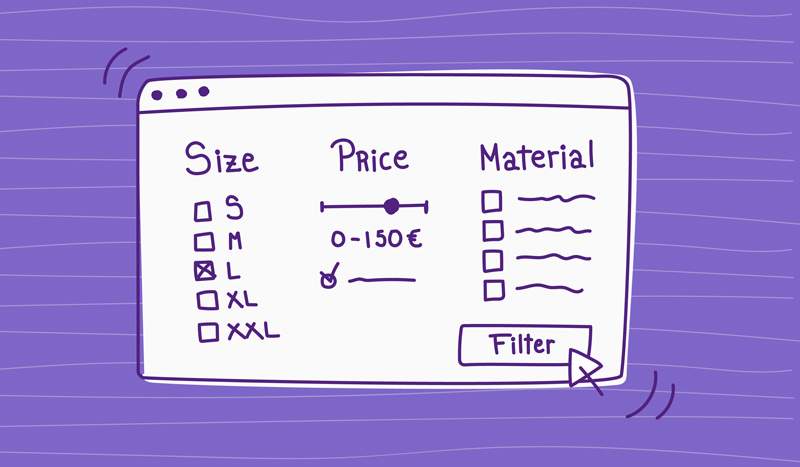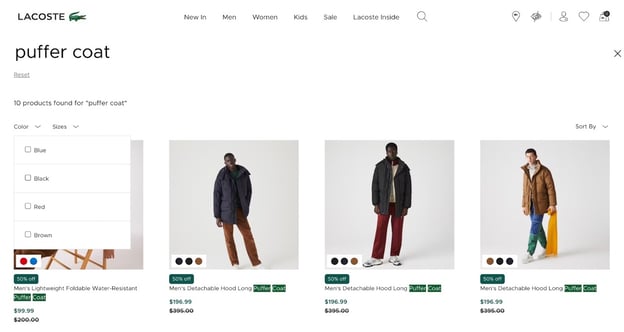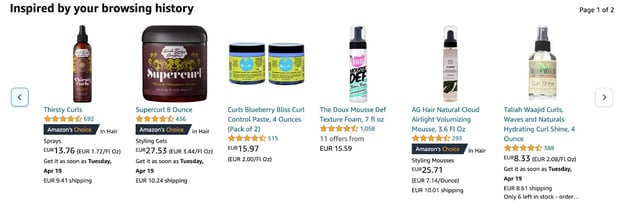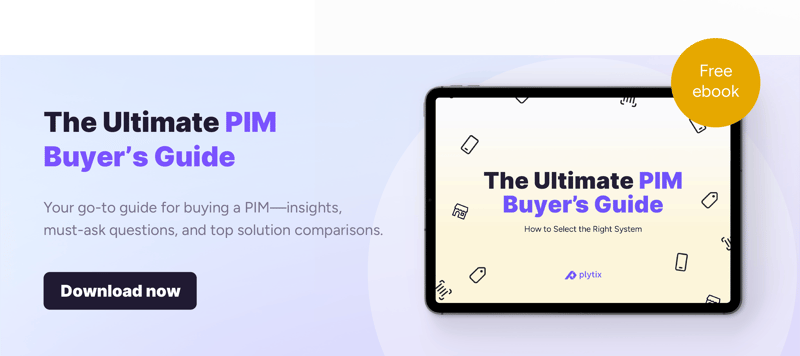Ecommerce Site Search Trends You Cannot Afford to Ignore

Keep the good stuff coming
Subscribe to our blog newsletter and get monthly content that helps you manage product data smarter.
No spam. Just real value.
Ecommerce search and product filtering functionalities are supposed to offer customers a rewarding online shopping experience. One that helps them easily navigate through a wide range of products to get to the product(s) they’re interested in buying.
However, this is not always the case as some ecommerce websites have poor site search designs and capabilities. To add salt to the wound, some of these websites also have weak organizational structures for their products creating poor product taxonomy.
Site search, filtering, and product taxonomy are an essential part of the ecommerce user experience (UX). Modern customer behavior suggests that online shoppers expect to get fast and relevant search experience. A well-designed and planned website taxonomy organizes your product content in a way that makes it easy for customers to find what they are looking for. Site search and filtering take this to the next level by ensuring that customers easily find a specific product they are looking for when they actively search for it.
For example, if they’re looking for a black hooded puffer coat, they should be able to instantly find the ‘coats’ category thanks to your clearly organized taxonomy. ALSO, they should be able to use the search bar or use any of the key product filters (e.g filter by color) to get to the specific coat they’re looking for.

But if the search results don't return relevant product information, customers will be very frustrated. And, that means they received a painful user experience, which more often than not, forces customers to abandon their search altogether.
That’s a potential customer and conversion lost to a competitor whose online shop provides a user experience design that is enjoyable and effective. The goal here is to be this competitor that customers flock to when they’re looking for the kind of products you sell. But to achieve this, you need to always be on top of the ecommerce site search trends to ensure that you deliver on customer expectations.
That’s why we’ve put together a list of the latest ecommerce site search trends so that you can improve the efficiency of your webstore navigation.
Multi-device search capabilities
Considering that 59% of customers complete a purchase on a different device to the one where they started their shopping journey, it’s clear that you need to optimize site search capabilities for all types of devices. That includes smartphones, tablets, and even desktops. Doing so ensures that customers enjoy the same experience no matter the device they use to interact with your business.
When you provide an integrated and seamless experience across different devices, you reduce friction and enable an enhanced user experience. Ultimately, you’re able to meet customer expectations, which can lead to:
- Customer satisfaction
- Positive brand reputation
- Customer loyalty
These are key ingredients to drive sales and conversions. Not to mention that they can help increase your customer retention rate.
Better personalized search experiences
We live in a time where personalization matters a lot to customers. It’s vital to remember that you cater to individual customers who have different needs when it comes to product information. So, personalizing their search experiences according to each customer’s expectation is guaranteed to influence a purchase decision. In fact, studies show that 66% of customers expect companies to understand their unique needs and expectations, and 59% of customers who have experienced personalization believe that it has a noticeable influence on their buying decisions.
Study customers’ search behaviors, so that the next time they visit your webstore, you can offer them an intuitive way to navigate your webstore based on their browsing and search history.

More intuitive search experiences
Speaking of intuitive, there are more ways to elevate customer searches than using their browsing and search history. You can guide online shoppers to find products they’re looking for even if they are unsure what words to use to search for the products. Or even if they make mistakes when typing the keywords on the search bar.
There are three ways to do this:
- Related searches and product recommendations - these types of search guides help customers discover products that are related to their searches. This is an opportunity for you to help guide a customer through their product discovery journey.
- Typo tolerance search - as the name suggests, this capability takes errors customers make when entering keywords into consideration and returns relevant results when the words are close to an existing keyword.
- Autocomplete search experience - similar to Google’s autocomplete predictive search, this enables customers to reach their search results faster as it completes a search they had intended to make.

Voice search
Although voice search is one of the slowest growing ecommerce trends, it’s worth considering. The number of voice assistants is growing rapidly, and there’s a prediction that by 2024 the number of digital voice assistants will reach 8.4 billion units. In this article, experts explain that the more voice assistants come to market, the higher the chances of a rapid growth in voice search.
What we’ve learned from 2020 through to 2022 because of the pandemic, is that it’s always beneficial to be prepared. So, optimizing for voice search is necessary to stay ready for the time voice search overwhelmingly explodes and become an essential part of ecommerce.
Visual search
Like voice search, visual search is in very early stages of usage in the ecommerce landscape. However, you cannot afford to ignore it because its potential is far too great. Imagine customers could upload real life images of products to search for similar products on your website and the results are exactly what they’re looking for. That’s the fastest way to drive them to checkout. According to this article, by 2023, the global visual search is expected to reach $14.72 million.
Customers love when their shopping journeys are easy and instant. There’s no doubt that visual search poses a better search experience than traditional text-based search that requires them to think carefully about the keywords they need to type in order to find their desired products.

Product information is at the forefront of the search experience
As you can see, the search experience begins and ends with product information. The higher the quality of your product data, the better search experience you provide your customers. We know that multichannel commerce is not easy, but you have the opportunity to make your life and theirs easy here. Invest in a product information management (PIM) system that helps you effectively store and manage all of your product content in a single source of truth.
Plytix is a PIM for ecommerce designed exactly for that purpose and more!
If you’re looking to make comparisons, download our free guide on how to pick a PIM that’s right for your business needs. Or book a demo with us to learn more!

What if your product data actually worked for you?
We’ll show you how Plytix helps you stop fixing data—and start using it.
Related posts
Keep the good stuff coming
Subscribe to our blog newsletter and get monthly content that helps you manage product data smarter.
No spam. Just real value.






Think others should see this?
Go ahead and share it.